| ■ J-PARC News - June 2016 (Issue #134) |
| ● New Material Development Technology, ADVANCED 4D NANO DESIGN, Receives 28th Society of Rubber Science and Technology Award (May 19, 2016 annual meeting of the Society of Rubber Science and Technology, Japan) |
|---|
| A new material development technology for tires, ADVANCED 4D NANO DESIGN, developed by Sumitomo Rubber Industries, Ltd., received the 28th Society of Rubber Science and Technology Award. This technology was developed through collaborative use of SPring-8, J-PARC's Materials and Life Science Experimental Facility (MLF), and the "K" supercomputer. This award was established by the Society of Rubber Science and Technology, Japan, and is presented to contributors to the development of the science, technology and industry of rubber and related fields. Using this new technology, Sumitomo Rubber Industries has successfully developed concept tires that improve anti-wear performance by 200% while maintaining low fuel consumption and good grip. |
|
| ● First Observation in Terms of Spin Motion of the Quantum Mechanical Phase of the Electron State using the Metallic Ferromagnet SrRuO3 (June 8, Press Release) |
|---|
| This research was carried out through a joint efforts by three groups: a group led by Prof. Shinichi Ito of the Institute of Materials Structure Science of the High Energy Accelerator Research Organization, KEK and the Neutron Science Section of J-PARC; a group led by Dr. Naoto Nagaosa (Deputy Director) and Dr. Yoshinori Tokura (Director) of the RIKEN Center for Emergent Matter Science (CEMS) ; and a group led by Prof. Je-Geun Park of Seoul National University. The metallic ferromagnet SrRuO3 has potential application in areas such as next-generation solar cells, and by using the High-Resolution Chopper Spectrometer (HRC) installed at the MLF of J-PARC, these researchers accurately measured the energy of the spin wave of this material as a function of temperature. In this way, they obtained information on the "quantum-mechanical phase of the electron state" and showed, for the first time in the world, that this phase can be related to an electron transport phenomenon called the "Hall effect." These results provide a new perspective for research on spin dynamics in magnets. |
| These research results were featured in the June 8 issue of the journal Nature Communications. |
| |
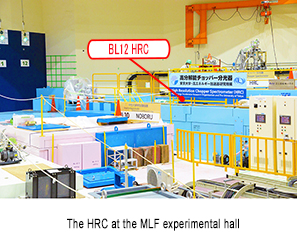
 * Click here to enlarge. * Click here to enlarge. |
| |
| ▲to Page Top |
| |
|
| ● SEI Layer Affects Battery Characteristics - Development of Techniques to Close in on the Layer's True Nature - (May 13, featured on the KEK home page) |
|---|
| A research group led by Hiroyuki Kawaura, Senior Researcher, Toyota Central Research and Development Laboratories, working jointly with Associate Professor Norifumi Yamada of KEK (J-PARC Neutron Science Section), has successfully used the SOFIA neutron reflectometer of the MLF to observe an SEI (Solid Electrolyte Interphase) layer forming on the boundary between an anode and electrolyte solution in the operating environment for charging lithium ion secondary batteries. The SEI layer is thought to have a major effect on battery performance, and based these results, findings are expected that may help improve battery performance. These research results were featured in the journal ACS Applied Materials & Interfaces of the American Chemical Society. |
| Supporting Information : H. Kawaura, M. Harada, Y. Kondo, H. Kondo, Y. Suganuma, N. Takahashi, J. Sugiyama, Y. Seno, and N. L Yamada "Operando Measurement of Solid Electrolyte Interphase Formation at Working Electrode of Li-ion Battery by Time-slicing Neutron Reflectometry", ACS Appl. Mater. Interfaces 8 (2016) pp 9540-9544. (DOI : 10.1021/acsami.6b01170) |
| |
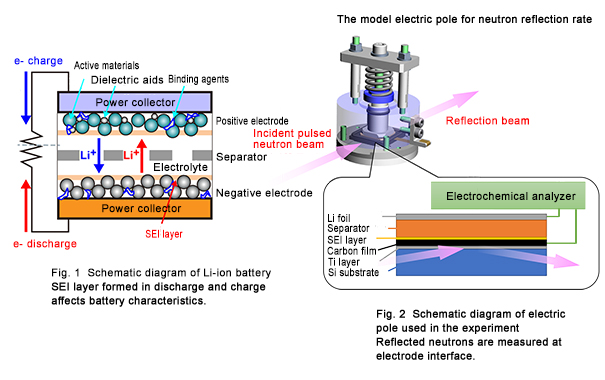
 * Click here to enlarge. * Click here to enlarge. |
| |
| ▲to Page Top |
| |
|
| ● Intensity of Proton Beam at MR (50 GeV Synchrotron) Reaches 425 kW (May 26) |
|---|
| The T2K (Tokai to Kamioka) experiment led the world in producing evidence of the electron antineutrino appearance phenomenon (electron antineutrinos are the antiparticles of electron neutrinos), and at present is closing in on the riddle of "CP symmetry breaking*" by neutrinos. The key to making this experiment a success is how to produce a large amount of neutrinos using the proton beam from MR, and increasing the intensity of the proton beam is extremely important. Since the start of construction, the target beam intensity for MR has been 750 kW, and as a result of previous beam adjustment tests, beam intensity recently reached 425 kW. When compared in terms of number of protons per pulse delivered onto the neutrino production target, new world records have been continually set since 2011. |
| *The asymmetry whereby almost no antimatter made up of antiparticles exists in the natural world. |
| |
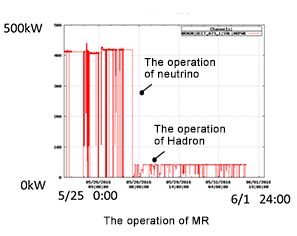
 * Click here to enlarge. * Click here to enlarge. |
| |
| ▲to Page Top |
| |
|
| ● The 3rd International Meeting for Large Neutrino Infrastructures (May 30-June 1, Kobayashi Hall, KEK) |
|---|
| The 3rd International Meeting for Large Neutrino Infrastructures was held with about 80 attendees from 12 countries, and more than 30 organizations. At this meeting, participants focused on next-generation large infrastructures for neutrino experiments-sharing information on scientific/organizational issues and progress of projects, and discussing the international cooperation system, related experiments, research and development, and other matters. The meeting opened with a talk by Prof. Takaaki Kajita, Director of the Institute for Cosmic Ray Research, University of Tokyo, on the significance of the Hyper-Kamiokande experiment which may help elucidate the origins of matter. Also, Dr. Naohito Saito, Director of the J-PARC Center, provided a basic overview of the outlook for increasing the intensity of the neutrino beams to be sent to Hyper-Kamiokande in the future. Over the two days of this conference, there were about 30 presentations by participants from various countries, and lively discussions on implementation of next-generation large neutrino projects. Some of the participants visited J-PARC on June 1, and toured the Neutrino Experimental Facility and other facilities of J-PARC. |
| |
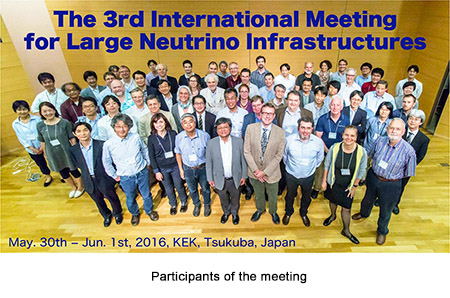
 * Click here to enlarge. * Click here to enlarge. |
| |
| ▲to Page Top |
| |
|
| ● T2K Neutrino Collaboration Meeting (May 23-28, Ibaraki Quantum Beam Research Center (IQBRC) ) |
|---|
| In the T2K experiment, neutrinos produced at J-PARC's Neutrino Experimental Facility are delivered to the Super-Kamiokande (SK) in Kamioka-cho, Gifu Prefecture, located 295 km away. This is a collaborative international experiment aiming to elucidate the mysteries of neutrino oscillation (transformation), and three times a year researchers from participating institutions all over the world gather for a collaboration meeting. Since May 2014, the T2K experiment has conducted experiments in the beam mode for muon antineutrinos, the antiparticles of the muon neutrino, and at this meeting, there were reports on the results of the latest data analysis carried out through May of this year, and discussions to bring together results for the XXVII International Conference on Neutrino Physics and Astrophysics to be held from July 4. Also, on the 27th, 11 students from various countries involved in the T2K experiment introduced themselves and gave short speeches on topics of their own choosing. |
| |
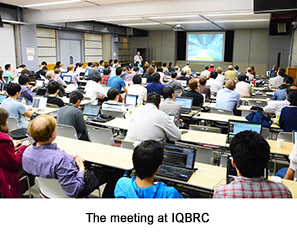
 * Click here to enlarge. * Click here to enlarge. |
| |
| ▲to Page Top |
| |
|
| ● J-PARC-ESS Collaboration Workshop (June 1-2, J-PARC Research Building) |
|---|
| Construction of the European Spallation Source (ESS) by 17 European countries is underway in the city of Lund in Scania province, Sweden, with operation scheduled to begin in FY2019. As part of ESS construction, a group of observers involved in the project visited J-PARC in November 2010. Information was exchanged regarding facility construction, infrastructure development and other topics-with participation by involved staff from local governments such as Tokai Village and Ibaraki Prefecture-and in June 2012, a collaboration agreement was signed with J-PARC regarding development of the ESS. Masatoshi Arai, former head of the Materials & Life Science Division (retired from J-PARC in March of last year), assisted ESS construction by acting as an advisor on the ground regarding all aspects of construction. The present plan has made overall decisions on elements such as the basic design of facilities and neutron source equipment, and is now shifting to the full-scale construction phase. This recent workshop was held to coincide with a tour of J-PARC by 16 staff from the ESS site in Sweden, primarily engineers. The workshop incorporated oral presentations and lively discussion on the latest development, research, and findings regarding both the technology and operation (including safety) of accelerators, neutron sources, and neutron instruments. For the entire afternoon of the accelerator maintenance day on June 1, the attendees took a facility tour guided by the staff in charge of each site. They entered the linac tunnel, and examined the accelerator main unit and the beam transport system from the 3 GeV synchrotron to the MLF. At the Central Control Building, they saw the accelerator control room, and at the MLF they toured the entire facility, including the room for handling radioactivated equipment where the mercury target is located. They also saw the state of the equipment with part of the shield removed from the front of the neutron source, and the inside of the spectrometer room. After the workshop was finished, the participants from ESS said it was a "very rewarding experience." |
| |
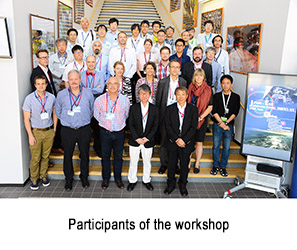
 * Click here to enlarge. * Click here to enlarge. |
| |
| ▲to Page Top |
| |
|
| ● 2nd Sumi-e Painting Lesson (May 27, KEK Tokai Dormitory) |
|---|
| A class to experience the traditional Japanese art of sumi-e (black-and-white ink painting) was held with the cooperation of the International Affairs Department of the Japan Atomic Energy Agency. The event was held at lunchtime during the T2K Collaboration Meeting, attended by a large number of researchers from overseas. Over 30 people participated in this sumi-e painting lesson, including some repeat students who attended the first lesson in April. While looking at sample sumi-e paintings of bamboo, vegetation, animals, food and other subjects, the attendees practiced on Japanese writing paper, and when they had gained some facility, painted on fans and colored paper. The participants once again produced wonderful works one would never expect from first-timers. |
| |
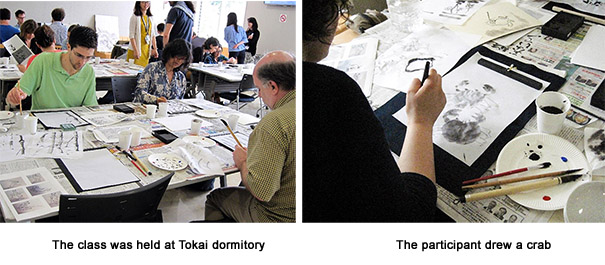
 * Click here to enlarge. * Click here to enlarge. |
| |
| ▲to Page Top |
| |
|
©2016 J-PARC Center. All rights reserved.
|
|